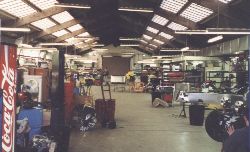 |
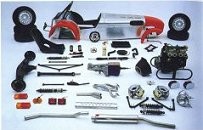 |
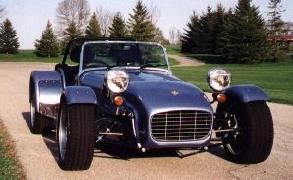 |
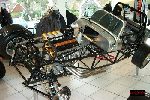 |
 |
| What's
a 7 ? |
live axle un-assembled car | The car | sectioned deDion car at Caterham | Lotus Mk 6 at Caterham |
Main Page Driving a Seven Build-page-story Build-page-pics Zetec vs. Cross-Flow Conversion to Zetec Gearbox upgrade Anecdotes & Stories Maintenance Log USA7-777 Gallery Registration Books Links |
The Caterham
Super Seven is a classic British Roadster, evolved from the
original
Lotus Super Seven. The Seven has a rich history which starts with it's
genius designer and Lotus founder (1952), the late
Colin Chapman (1928-1982). 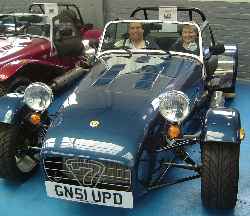 The essence
is to have form follow function, therefore to go fast it must be light.
With
continued development the pure form has emerged. In
various forms
perhaps
the Lotus 6 is the predecessor to the 7 series I, II, III. The IV being
a change in philosophy, but reflective of the views of the time. The
series
III was the true predecessor for the Caterham 7 (there is a 21
as well
- a full bodied 7). On the right, at Caterham (fall '05), Lia and I try
out the roomier, wider bodied SV Caterham. My
better half, Lia,
liked it and thinks I should upgrade (really?). The essence
is to have form follow function, therefore to go fast it must be light.
With
continued development the pure form has emerged. In
various forms
perhaps
the Lotus 6 is the predecessor to the 7 series I, II, III. The IV being
a change in philosophy, but reflective of the views of the time. The
series
III was the true predecessor for the Caterham 7 (there is a 21
as well
- a full bodied 7). On the right, at Caterham (fall '05), Lia and I try
out the roomier, wider bodied SV Caterham. My
better half, Lia,
liked it and thinks I should upgrade (really?).Some History: The name "Caterham" was adopted from the sales
office homebase village,
Caterham, just
South of London. Since then a number of other enthusiast around the
planet have made
other
incarnations and replica's. There is Donkervoort, Westfield, Birkin,
Robin
Hood, Dax Rush to name a few. There is always a
heated debate on which 7 is the direct
descendant of the original, but there is no doubt that today's Caterham
is an outstanding evolution of the original Lotus. Careful development by Caterham have
improved
considerably
on the original Lotus design, with more precise suspension geometry,
e.g.
full double A-arm front suspension, and a return to the original deDion
suspension that was found on the very first 7's. The so-called "long
cockpit
design, preserved nearly all internal and all external dimensions of
the original
Lotus, except it moved the rear bulkhead back by a couple of inches, to
create
more legroom and allowed use of adjustable seats, as not everyone was
or
is identical to Colin Chapman with a 5'8" stature. Also, the passenger
footbox was extended, allowing most passengers to travel with their
legs extended. Detailed
developments
improved overall chassis stiffness as well as accommodation for newer
engines. Characteristic for a Seven is the razor sharp handling and the open wheel racer seating position. In fact these cars handle so well, that in many racing events they are only appropriately raced against each other. Handling and control are extremely well balanced and likely for the first time offer a good driver a vehicle where he or she is the limit, rather than the car. Improvements can be made, there are several options offered by the factory, primarily to deal with the different environment that exists on the racetrack vs the open road. For the track, suspension tuning is accommodated by the available suspension adjustments. All critical parameters can be modified. Performance is defined by cornering ability and acceleration. Even with a modest 100 BHP horsepower on board, the 1300lbs car's acceleration will outdo most cars. 4 cylinder Ford, Vauxhall and Rover engines from 1400 - 2000 cc in various states of tune provide from 100 - 250 BHP, some even higher. With most around 120 - 150 BHP.Gearboxes are typically Ford 4 or 5 speed, or Caterham's 6 speed box. With a curb weight around 1300lbs, and 185 - 215 size tires (13"-16") handling is phenomenal. Control numbing power assists are neither available, nor needed for steering or braking. 0-60mph times are around 5 sec and lateral acceleration on street tires around 1.1 ... 1.3 G's depending on road surface and temperature. |
|||
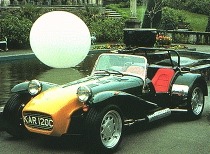 |
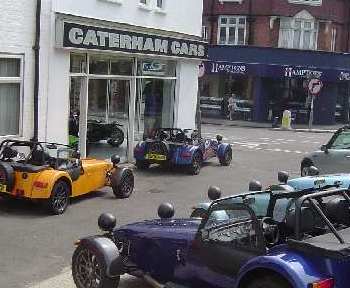 |
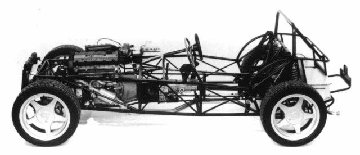 |
||
| Separate from the driving experience is the build experience, which is available for those who prefer to assemble the car themselves. Originally this was a path chosen by Colin Chapman to avoid excessive sales tax. In the 1960's a Seven could be had for #1000-#2000. As Caterham evolved the car, it became more sophisticated and optimized for fast road and track use. Also, the kit form is not exactly from the ground up. In purist form many hand assembly stages at Arch Motors, where the chassis is created and the Dartford Caterham factory precede the presentation of the car as a "KIT", but it is more accurate to refer to it as an "unassembled" car. In less than a hundred hours, someone with average technical skills can assemble it. The assembly experience itself has become part of the Seven cult. It demands frequent but modest attention, and having assembled the car will provide the familiarity that helps to resolve issues if they emerge. The cost savings from building it yourself are incidental, at least in the USA. Even if the unassembled vs. assembled costs were the same, I would still elect the build experience. | ||||